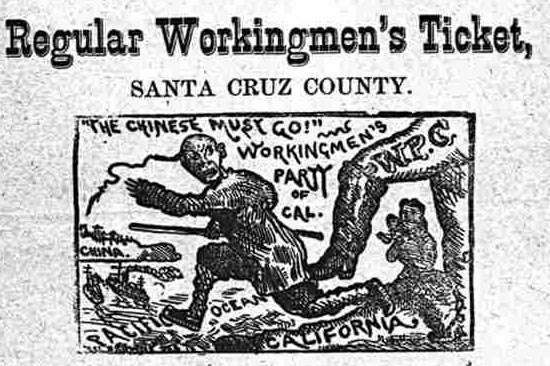America’s Anti-Asian History

The pandemic has led to another spate of anti-Asian violence. There’s been a good bit of reporting about these incidents lately. It’s quite depressing. It’s worth noting here that while our public discussions of racist violence tends to focus almost exclusively on Black Americans, the history of anti-Asian violence extends very deep and is almost always a constant low-level issue that the media mostly ignores. There’s hardly been a period in American history when anti-Asian violence hasn’t been a serious issue since 1849. Violence against the Chinese in California that spread around the West by the 1870s, the Chinese Exclusion Act, the Gentlemen’s Agreement with Japan to end migration after San Francisco whites demanded the exclusion of Japanese kids from public schools, violence against Filipinos in California for having sex with white women in the 1930s, placing the Japanese in concentration camps during World War II, autoworkers murdering Vincent Chin thinking he was Japanese, attacks on Sikhs after 9/11 because they wear turbans and thus are Muslims or something. The list goes on. Once, in the mid-90s, my grandparents were visiting and we went to a Chinese restaurant with them. Some guy was unhappy with the service or something and started shouting that we beat them in World War II and how dare they come here and provide bad service. At a Chinese restaurant.
In any case, this is something that needs a lot more attention. Hua Hsu has some thoughts:
For decades, Asian people in America tended to identify more with their own nationality and ethnicity than with a broad Asian-American community. But, in the sixties and seventies, a more inclusive sense of Asian-American identity grew out of a desire for political solidarity. This new identity assumed a kind of cross-generational ethos, as younger people forged connections with older immigrants, helping them to navigate social services and to understand their rights. And it found clarity through collective struggle, as when, in 1977, in San Francisco, Asian-American community organizers, aided by a multiracial coalition of allies, came to the defense of a group of elderly Asians, mostly Filipino men, who were being evicted from their longtime homes in the I-Hotel. But the real turning point came in 1982, when two white men, one of whom had been laid off from his job as an autoworker, followed Vincent Chin, a young Chinese-American draftsman, from a Detroit bar to a nearby McDonald’s and beat him to death. Witnesses said that the three had initially fought at the bar, and that during the altercation the men had allegedly mistaken Chin for Japanese and blamed him for the American auto industry’s decline. The men later claimed that it was a fight that had gotten out of hand, and that they were not motivated by Chin’s race. They were given probation and fined. The lenient sentencing sparked a national campaign against anti-Asian racism and inspired an Oscar-nominated documentary, “Who Killed Vincent Chin?”
In contrast to racism against other groups, anti-Asian racism has rarely been as gruesome and blatant as it was in the Chin killing. There have of course been other violent incidents, like the “Chinese massacre” that occurred in Los Angeles, in 1871, or the Sikh-temple shooting in Oak Creek, Wisconsin, in 2012. But the history of Asian victimhood in America is varied and muddled. A presumption of foreignness might link exclusionary immigration policies of the nineteenth century to the internment of the Japanese during the Second World War; the paranoia around Asian-American scientists, which resulted in the mistreatment of a Taiwanese-American nuclear scientist named Wen Ho Lee, in the nineteen-nineties; and post-9/11 Islamophobia. Yet even the effects of these broad patterns of discrimination aren’t uniformly felt. And the needs and disadvantages of refugee communities and poor Asian Americans have been obscured as much by the myth of Asians as the “model minority” as by the movements, particularly among the professional class, to resist this myth.
The current moment underscores the in-between space that Asian Americans inhabit. It’s hard to prove bias in a hate crime, and it’s typically done by showing how a particular crime draws on recognizable histories of violence or neglect. This becomes difficult when people are mystified by the idea of anti-Asian racism. In Chin’s case, the culprits were white men who espoused racist ideas, which made it easier to recognize the assault as a hate crime and to organize the community around it. Some recent attacks also make legible the ways in which systemic injustices afflict Asian Americans. In late December, police officers killed a Chinese-American named Christian Hall in Monroe County, Pennsylvania; soon after, a Filipino-American man named Angelo Quinto died, after a police officer choked him by kneeling on his neck in Antioch, California. Both Hall and Quinto were suffering from mental-health episodes at the time. Officers claimed that Hall, who was standing on an overpass, pointed a gun in their direction. Quinto died as his family, who had called the police out of concern, looked on. Campaigns fighting for the officers to be held accountable fluidly align with the movement for Black lives, and the criticism of the criminal-justice system’s overreach and potential for brutality.
I think this is right. The “model minority” stuff is really damaging. A group can’t be the “accepted” group in American society when they are still murdered for any number of reasons by racist whites or by cops. But yet, that structure contributes to the marginalization of their concerns and the long history of anti-Asian violence in this country. It’s a serious problem and we need to pay more attention to it.


